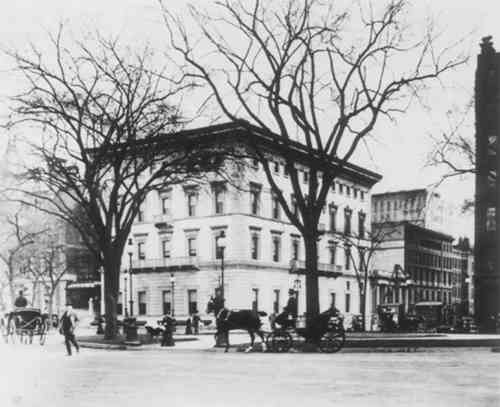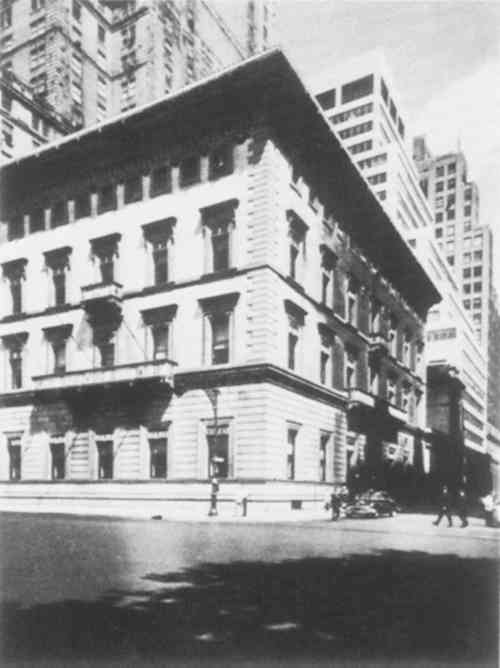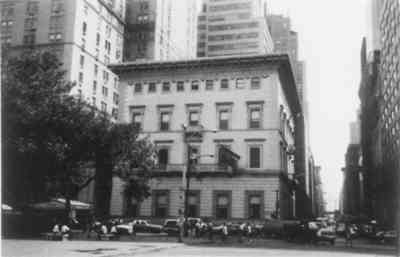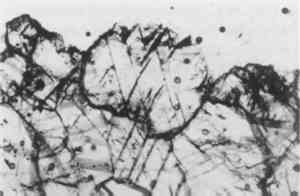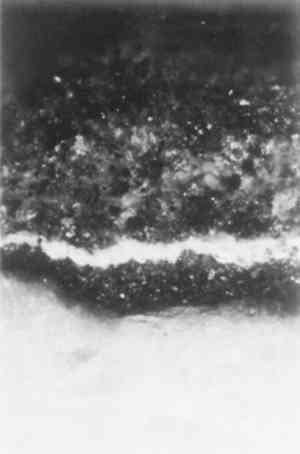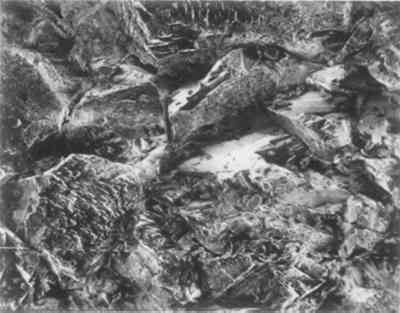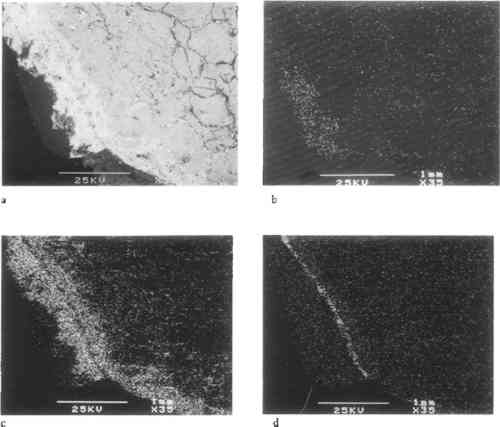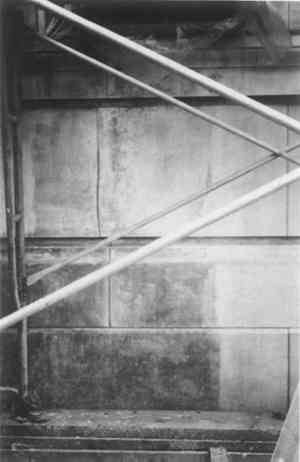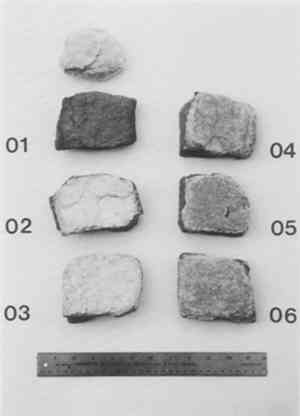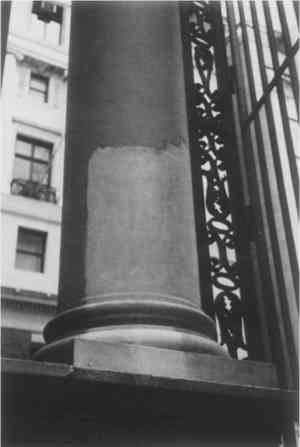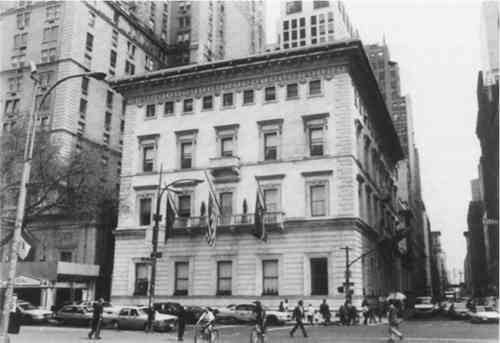CLEANING, IRON STAIN REMOVAL, AND SURFACE REPAIR OF ARCHITECTURAL MARBLE AND CRYSTALLINE LIMESTONE: THE METROPOLITAN CLUBFRANK G. MATERO, & ALBERTO A. TAGLE
ABSTRACT—The Metropolitan Club, designed and built in New York City by McKim, Mead, and White in the 1890s, has particularly extravagant exterior stonework. However, as a result of the type of stone selected, natural weathering, and improper maintenance over time, the stonework had become severely discolored and eroded by 1989. The authors first characterize the stones used and describe the types of damage found, all identified with various analytical techniques, including thin-section petrography, scanning electron microscopy, and energy-dispersive x-ray spectroscopy. The authors then discuss the treatments carried out on the stonework, including metallic stain removal, consolidation, and mechanical repairs. 1 INTRODUCTIONDespite the popular belief in the immutable durability of stone as a building material, architects, sculptors, geologists, and conservators alike are well aware of the material's inevitable alteration over time. Improved examination and analysis methods have helped explain the susceptibility of many stones to a broad and complex array of decay mechanisms. These natural weathering processes have been further complicated—often reduced and sometimes accelerated—by a long history of conservation and repair techniques. Correlation between the durability, performance, and weathering of building stone and its geochemical makeup can be traced to antiquity and the Renaissance through Vitruvius in the 1st century B.C. and and Leon Battista Alberti in the 15th century. Their observations were amplified in the late 19th century with the development of the geological sciences and the growth of the stone industries in America. With a deeper understanding came a broader audience. Current conservation thinking assumes a methodological approach to the issues of stone deterioration and treatment. This assumption is based on an established system of principles, practices, and procedures as developed specifically for the preservation of stone buildings and monuments. Such an approach depends on a wide range of information and the contributions of various research methods, including an understanding of a structure's original and subsequent design goals and construction history, materials characterization and identification through scientific investigations, and objective treatment evaluation using laboratory and field assessment. Integrated thinking is necessary for the successful conservation of complex stone buildings and monuments; current and future use and maintenance must also be taken into account. The recent treatment of the exterior stonework of the Metropolitan Club in New York City affords an excellent opportunity to examine the value of this approach in some detail for North American building stone and to present new information on the mechanisms and large-scale treatment of iron-stained limestone and marble. 2 THE BUILDING: DESIGN AND CONSTRUCTIONThe Metropolitan Club was designed and constructed from 1891 to 1894 by the prominent New York architectural firm of McKim, Mead, and White (fig. 1).1 Established as a new club for the city's wealthiest and most influential men, the building was designed to be a clear public statement of their power, wealth, and position. The club took almost three years to design, build, and furnish at a cost of nearly $2 million, all financed by member pledges. Of that cost, nearly one-quarter went to the building's extravagant exterior stonework. So impressive was the result that in 1901, seven years after the building's completion, the noted architectural historian and critic Montgomery Schuyler described it as “the largest, most imposing, and most luxurious of the club-houses of New York” (1894, 226).
Men's clubs were a well-established tradition in early New York, and by the end of the 19th century the clubhouse had emerged as a specific building type in Europe and North America. The Metropolitan Club was McKim, Mead, and White's most ambitious clubhouse design to date, begun just after the completion of a building for the Century Association in 1891.2 White's free use of Italian Renaissance palazzo designs as precedents for both club buildings fell well within the firm's growing preference for the classical tenets of the Renaissance as reflected in the earlier Henry Villard Houses in New York (completed 1886) and the Boston Public Library (begun 1887). The successful adaptation of the Italian Renaissance palazzo as a suitable form for the urban clubhouse had been established earlier in London by Sir Charles Barry and Decimus Burton in their designs for the Travellers' Club (1830–32) and the Reform Club (1838–40); however, McKim, Mead, and White's versions were larger in scale. Despite the common function and shared sources for the clubhouses of the Century Association and the Metropolitan Club, White's exterior designs for each were vastly different in their massing, materials, and ornamentation to a Such design contrasts embody and reflect the apparent ideological differences between the two clubs and their intended public image. In this regard, the ultimate decision to construct the Metropolitan Club in white marble had a profound effect on its appearance and the image it conveyed. White himself said of the building after the publication of his designs in 1892:
Building records charting the construction history of the clubhouse clearly document many of the issues relating to the design and selection of the exterior stone. These accounts–when viewed in the context of prevailing building practices, the American stone industries, and the emerging science of economic geology and petrology–offer new insight into the selection of the club's building stone and its subsequent deterioration problems. Construction on the foundations began on May 19, 1891; however, it was not until November 20 of that year that the architects and Building Committee first convened to discuss the details of the exterior. It is clear from the numerous specifications and estimates dated as early as July 1891 that the original intention was to build the clubhouse of a light-colored brick with marble trimmings and a granite basement, a scheme similar to that employed at the Century Club. However, additional alternate estimates for an all-stone building were requested at the same time, suggesting an early consideration for the eventual final scheme.4 Although the architects had made no exact specification for the stonework other than “marble or Indiana limestone,” initial and revised estimates submitted by George Mann of Baltimore and receipts for stone quarried, delivered, and set suggest that “Beaver Dam marble” from Maryland was in fact used for the building's basement ashlar and lower east party walls, base course, balcony balusters and panels, first-story window jambs and lintels, pedestals, and north wall trimmings. In addition, Norcross Brothers of Worcester, Massachusetts, supplied a tooled “Tuckahoe marble” from Westchester County, New York, for 18 window jambs and lintels and granite for the exterior steps and copings. In July 1892, the Building Committee, after much deliberation and with construction already well under way, reconsidered its original scheme of brick and stone and instead approved its earlier alternate of an all-stone building. This plan was approved two months later, and the recommendation was eventually made to have the entire building constructed of marble. Estimates solicited by the architects for the new upper-story ashlar indicate that a tooled Tuckahoe or Beaver Dam marble—the same stone proposed for the lower story and trimmings–was the preferred choice. However, due to tooling costs and the possibility of quarry shortages, a rubbed Rutland white marble supplied by the Vermont Marble Company was selected instead. Setting of the upper-story ashlar and carving of the garlands was done by George Mann, who supplied the majority of the stone for the lower story as well. The desirability of a uniform white appearance of the stone and the The final drawings and presentation photographs later published in 1915 described the building as built with tooled Rocky Creek, Maryland, white marble and rubbed Vermont white marble (Roth 1979). According to the paid invoices, this later description is partly inaccurate in that stone from both Maryland (“Beaver Dam”) and New York (“Tuckahoe”) was used instead in addition to the Vermont marble ashlar. Furthermore, the designation of the Maryland stone as “Rocky Creek” rather than “Beaver Dam” suggests some confusion in terms of the quarry that supplied the Maryland crystalline limestone.6 3 THE STONEDespite the massive and imposing appearance of the building's ashlar walls, what appears to be a tour de force of traditional load-bearing masonry is actually a 4 in. stone veneer attached to an internal steel frame with brick backing, construction typical for the period. The selection of a fine, smooth rubbed Vermont white marble in combination with the coarse, tooled crystalline limestones of New York and Maryland would have provided a subtle yet elegant contrast in color and texture (see fig. 1). However, the partly random combination of different crystalline limestones7 and the use of inferior stone due to construction delays caused serious problems of discoloration and staining that quickly obliterated the original tonal effect.8 Selection of these individual stones and their combination was not unusual given their widespread use and popularity among American architects and builders at that time. The crystalline limestones of Westchester County, New York, and northern Maryland had a long tradition of commerical architectural use since the early 19th century due to their reported hardness, whiteness, and availability in large blocks free from faults and jointing (Urquhart 1986). The Vermont marble quarries, although also commercially exploited during the latter half of the 19th century, were not as popular due to limited accessibility. However, by the end of the century, improved shipping routes and increased promotion of the wide variety of fine white and colored marbles available made the Vermont quarries one of the largest domestic marble suppliers in the country. The Rutland white marble used for the upper ashlar walls at the Metropolitan Club enjoyed a well-deserved reputation for its nearly blemish-free fine-textured appearance and was a popular choice and competitor with imported Italian statuary marble. The Maryland and Tuckahoe stones, on the other hand, are both crystalline dolomitic limestones–not true marble due to their incomplete metamorphosis–composed of a large percentage of dolomite in addition to calcite. They are both distinctive in their unusually large grain size and the occurrence of the secondary silicate minerals tremolite and phlogopite. The former often appears on the surface after weathering as pronounced dark crystalline inclusions, and the latter appears as irregular tawny micaceous bands. The stone also contains a small percentage of ferruginous accessory minerals: hematite and pyrite, which on exposure and weathering impart a brassy yellow or streaky orange-brown color to the stone. This weathering phenomenon, reported in the geological literature for both stones, had been noted in particular for the Tuckahoe stone at least 10 years earlier in New York City, in 1879 (Julien 1884). Despite these observations, both stones enjoyed widespread use, no doubt for their initial dazzling white appearance, availability in large blocks, and close proximity and easy removal and transport to the major East Coast cities. McKim, Mead, and White had in fact used the Tuckahoe stone for many other projects, including the Century Club and the Washington Square Arch, both in New York City. Yet by 1900, only 16 years after the completion of the building, a rustlike discoloration of the Metropolitan Club's stone was reported, especially on the base, confirming the warnings of earlier observations. Despite proposals for mechanical and chemical cleaning at this early date, the condition went untreated until 1931, when the architects again noted the worsening discoloration of the stone and suggested that the building be cleaned. Apparently, nothing further was done to the exterior (fig. 2) until 1965, when the building was reportedly steam cleaned and painted. Painting became the preferred method of cosmetic treatment during the next 20 years, imparting a dead pallor of drab gray and concealing the dazzling, albeit marred, whiteness of the stone (fig. 3).
4 CONSERVATION PROGRAM4.1 EXAMINATION AND ANALYSIS In 1985, the Center for Preservation Research, Columbia University (Frank G. Matero, director) undertook preliminary examination of the exterior for James Stewart Polshek Associates. In 1989, the club began full study of the exterior stone masonry in preparation for exterior cleaning. In addition to the archival
Samples of both marble and limestone taken from protected (i.e., rain-sheltered) areas also revealed thick black gypsum crusts with embedded airborne particulates of carbon soot, fly ash, iron, and other metals typically found on calcareous stones in polluted urban environments (figs. 6–8). Such crusts were most prevalent on the south elevation, where the narrow street, surrounding tall buildings, and heavy traffic all contributed to the formation and retention of pollution-related soiling and sulfate crusts under and over the paint layers.
Weathering of each stone type was assessed using thin-section petrography and scanning electron microscopy as well as by visual inspection on site. At high magnification all exposed samples exhibited surface etching and cracking of crystal faces, conditions that can be attributed
Deterioration of the dolomitic crystalline limestone was restricted to the carved details and arises of protected elements subject to water saturation and slow drying, such as the balcony consoles and soffit moldings. In these locations, disaggregation of the stone was observed in cross section as microcracking along the grain boundaries in association with visible crystalline deposits. The localized concentration of sulfur detected by SEM-EDX in a layered structure on the surface and along the detached grain boundaries suggests the presence of gypsum formed by the action of atmospheric SO2, both as a complex crust and within the grain structure as cryptofluorescence, the latter a result of capillary migration in a humid environment (fig. 11). The internal formation of sulfates within the stone's upper matrix due to oxydation of pyrites increases this microcracking and resultant disaggregation; the condition undoubtedly has been worsened by freeze-thaw cycling as a result of increased water permeability and surface area and decreased intergranular cohesive strength.
In addition to these deterioration phenomena, the crystalline dolomitic limestone exhibited unique widespread staining, ranging in color from pale orange to deep rust red. Staining appeared to be greatest in those areas of heavy water exposure and soaking, such as the water table and windowsills. In thin-section examination under normal and polarized transmitted light, this discoloration appears as a fairly even zone extending down 2 mm from the surface with distinct darkened grain boundaries (see fig. 4). This dark intergranular material can be identified using SEM-EDX as iron, presumably originating from the naturally occurring pyrite (iron sulfides) and hematite (iron-III oxide), commonly reported as intrinsic and altered accessory minerals in this stone (see fig. 11). The general mechanism for the type of intrinsic ferruginous staining observed in the crystalline limestones of the Metropolitan Club has been described in the literature as the diffusional transport of colloidal particles formed by the oxidation of ferruginous mineral inclusions In an outdoor environment, the limestone is subject to two main agents: acidic water and oxygen, which will affect the iron-bearing accessory minerals in the stone in several ways, simplified as:
All together, the humid atmosphere and the acidic environment, regardless of the effect caused to the stone matrix, will create the conditions for the iron stains, which can be expressed in the final equation:
In this case, hydrated ferric hydroxides and ferric sulphates are responsible for the iron-based discolorations. This is a simplified explanation of a very complex natural phenomenon that does not take into account the stability of the formed compounds in the medium (stone) or any other possible interactions. Nevertheless, it provides a reasonable explanation for the intrinsic iron staining observed on the crystalline limestones. In addition, the resulting acid in the calcite matrix will react to form gypsum:
In its own way, hematite will hydrate as:
Metallic staining, especially on light-colored stone, is generally considered to be one of the most difficult cleaning problems encountered for porous building materials. Such stains, regardless of their metallic species, can be attributed to either extrinsic or intrinsic sources. Extrinsic metallic staining is most often due to the corrosion of associated architectural metalwork, especially of iron, copper, and the copper alloys brass and bronze. These elements generally include internal anchors, pins, rebar, or associated features such as roofs, flashing, or decorative grilles. Also included is staining resulting from the deposition of metallic particulates found in most airborne pollution and constituting an average of approximately 10% (by weight) of urban grime or dry deposition (Cutter and Kissa 1987). Such staining was observed at the Metropolitan Club on protected ashlar surfaces of the Vermont marble in combination with thin surface crusts of gypsum and carbon soot. Intrinsic sources of metallic staining are usually the accessory or secondary minerals of the stone itself, which can occur as isolated inclusions or as distributed material in the crystalline matrix, as in the case of the Metropolitan Club's crystalline limestones. Obviously intrinsic sources of metallic staining present far greater problems in their treatment and control given the difficulty of removing or controlling the source. 4.2 PAINT REMOVAL AND CLEANINGBefore an evaluation of paint removal techniques could be made and the existing condition of the stone established, in situ tests with a variety of commerical alkaline and organic solvent paint strippers were first performed. These tests were executed in various locations to observe product performance and to determine the most appropriate dwell times, application conditions, and residue removal and collection procedures for the different stones. The contractor selected a potassium hydroxide-based commercial paint stripper (Deidrich 606X Paint Stripper) as the most expedient means of completely removing all layers of overpaint. One application of 3–4 hours was followed by a pressure water rinse of 400–600 psi. After removal of the paint stripper residue, any remaining potassium hydroxide was neutralized with a rinse of dilute phosphoric and acetic acids (Sure Klean Limestone Afterwash). After full removal of the paint, localized soiling and staining of varying degrees (suggested by the sample cross sections and early photographs) was revealed, helping to explain the club's initial decision to paint the building in 1967 (fig. 12). Although the records suggest that the building was steam cleaned prior to painting, the irregular black soiled surface under the paint clearly indicated that the process was either bypassed or poorly executed. Beginning with the most basic of techniques, all stone surfaces were washed with a low-volume, low-pressure (1–2 gals/min.) water spray for generally 24 hours with city water filtered through an industrial in-line particulate water filter as a precaution against iron particulate contamination from aged water pipes. Contact time was occasionally longer depending on the severity of the soiling and the thickness of the protected crusts. Because of the potential danger of water damage to the club's elaborate interiors through exterior leaks, all windows were temporarily covered with polyethylene-covered frames, and all open joints were temporarily sealed prior to paint removal and aqueous cleaning. Partial repointing was undertaken only after cleaning to ensure an accurate match with the existing mortar.
The water spray cleaning performed effectively in removing the majority of the overall black soiling (occurring on 30–40% of the total building surface), especially from the Vermont marble (see fig. 12). Complete removal of the soiling and much of the ligthter ferruginous 4.3 IRON STAIN REMOVALThe removal of obscuring paints and disfiguring soiling and crusts revealed what cross sections had already suggested: large areas of orange ferruginous staining on much of the crystalline limestone. Metallic stains and their removal from masonry represent a problem chemically different from that of the surface soiling and encrustation described above. One of the best approaches for the removal of such deep-seated stains is the use of chemical complexing or sequestering agents. These compounds will react with the metallic ion responsible for the discoloration to yield a stable, soluble species that can diffuse into the solvent and be removed when the liquid phase is soaked up or flushed away. The ideal agent should react rapidly with the metallic stain to yield a stable complex compound and not form a soluble complex ion or a soluble substance with any of the constituents of the stone, such as calcium or magnesium. In addition, any such complexing agent under consideration should be of relatively low cost for large-scale building application. Complexing agents are not new to conservation practice. Such compounds have been used for selective cleaning, desalination, stain removal, and treatment reversal for many years on small museum objects (Richey 1975; Chartier 1991). Chelating agents such as EDTA (ethylenediaminetetraacetic acid) have been used for rust reduction, salt removal, and iron and copper stain removal from stone, leather, bone, and textiles and for the removal of accretions from archaeological ceramics and glass. Use of ammonium citrate for conservation treatments has been tested and reported to clean rust from metallic artifacts, especially when the presence of chlorides must be avoided (Mibach and Organ 1972). For the removal of iron stains from stone, sodium citrate has been reported in use as early as 1957 (Amoroso and Fassina 1983), EDTA (Detarol) in 1962 (Plenderleith 1971), and citric acid, oxalic acid, and EDTA in 1976 (Rinne 1976). Stambolov (1968) addressed the problem specifically for calcareous stone, citing only sodium citrate among other compounds as effective. Perhaps the most insightful early discussion of the mechanisms of ferruginous staining on stone was published by Lewin and Rock (1976). Through experimental models, they assessed the effects of phosphates, fluorides, oxalates, and salicylates as complexing agents for hydrous iron-oxide staining on stone. According to their results, none of these compounds proved desirable for carbonate stones due to their poor efficiency or attack on the stone. Experiments on the treatment of discolored concrete (Greening and Landgren 1966), as well as rust removal from weathered Indiana limestone (Gale and Weiss 1982) using ammonium citrate, cited good results. However, the process can be dangerous to carbonate rocks, as ammonium citrate has an acidic hydrolysis. The effectiveness of the ammonium citrate salt in comparison with other citrate salts, especially when buffered with ammonium hydroxide for use on acid-sensitive carbonate rocks, has never been adequately addressed or explained. In fact, when applied in an alkaline solution (pH 9.0) as a poultice prepared with ammonium hydroxide or following potassium hydroxide cleaning treatments, improved stain removal has The formation of ferric-ammonium citrate can be outlined as follows. Iron forms two different types of chelates with citric acid. Iron-II ions form very unstable complexes, which oxidize easily into iron-III compounds. These compounds can be of two types, one of reddish brown color in a basic medium, [Fe3(C6H5O7)2(OH)2(H2O)2]3C6H5O7.18H2O; and one of greenish color in an acidic environment, H6[Fe2(C6H4O7)3]. Sodium citrate in the poultice medium forms two types of complexes, one of greenish color in an acidic medium, Na3H3[Fe2(C6H4O7)3], and one of reddish brown color upon addition of sodium hydroxide, turning the medium basic, Na3Fe2(C6H5O7)2. The presence of ammonia allows the formation of different compounds. Iron-II builds unstable complexes that oxidize easily into the iron-III compounds. These compounds can be of two types, which are highly soluble in water in contrast to the ammonium-free compounds. Depending on the basicity of the medium (the hydrolysis of ammonium citrate is slightly acidic), the following green complex is formed: {Fe[C6H5O7(FeOH)][C6H4(FeO)O7(NH4)2](H2O)2}3C6H5O7.6H2O. Increasing the amount of ammonia in the solution forms a reddish brown complex, {Fe[C6H4(FeO)O7(NH4)2]2(H2O)2}3C6H5O7.�H2O, when the medium is clearly ammoniacal. The presence of both green and reddish brown complexes was confirmed in an experiment designed to assess the comparative efficacy of ammonium and sodium citrate at varying pH with and without ammonium hydroxide (fig. 13). Six samples of a naturally weathered, medium-grained, nearly pure calcitic marble were artificially stained by soaking them in a solution of hydrated iron-II sulfate (copperas), which quickly oxidized to a deep orange-brown iron-III sulfide. The following stain removal tests were then performed with poultices of Fuller's Earth mixed with saturated solutions of ammonium and sodium citrate prepared with deionized water at room temperature (24�C).
Sample 1: Control (no treatment) Sample 2:Ammonium citrate with sodium hydroxide (pH 9.0) Sample 3:Ammonium citrate with ammonium hydroxide (pH 9.0) Sample 4:Ammonium citrate with ammonium hydroxide (pH 7.0) Sample 5:Sodium citrate (pH 9.0) Sample 6:Ammonium citrate with ammonium hydroxide (pH 8.0) Each poultice was applied three times to each sample; each application was covered with plastic film to ensure a consistent dwell time of 24 hours and then unwrapped and allowed to air dry before mechanical removal and rinsing of the poultice. The results of the laboratory tests confirm what had been observed in the field. Samples 2 and 3, both treated with ammonium citrate at a pH of 9.0, generally displayed the best stain removal. Of these, sample 3 showed the greatest improvement in stain reduction. Sample 5, prepared with sodium citrate at a pH of 9.0, affected some stain reduction but induced flaking damage to the stone as a result of the recrystallization of sodium salts. Ammonium citrate in an alkaline ammonia solution appears to be the safest and most effective method of applying citrates to eliminate iron stains in carbonate rocks. The better performance of the ammoniacal ammonium citrate medium can be explained considering the following points:
As a cleaning method for ferruginous material in carbonate rocks, ammoniacal ammonium citrate poultices also offer a safer pH range (pH 9.0) so as not to allow the acidity of the remaining citric acid to attack the carbonates of the stone. Sodium citrate, the more 4.4 FIELD APPLICATIONThe translation of custom formulations created in the laboratory into wide-scale application can be a difficult process, especially if the processes involved in their manufacture and use are sensitive, labor intensive, or hazardous. Fortunately, the use of an ammoniacal citrate poultice was feasible for this critical phase of cleaning due to its efficacy and ease in preparation, application, and relatively low cost. This availability was important, since no other commercial cleaning products formulated for the treatment of metallic, specifically iron, stains were found to be as safe or effective as the ammonium citrate-ammonium hydroxide treatment. Successful treatment of the stains, however, did require the preparation of detailed specifications for the controlled preparation and application of the poultices (see appendix A) and the creation of mock-ups, or controls, on site to establish a norm and cleaning reference for the contractor (fig. 14).
Large-scale poultice cleaning proved to be a highly effective and controllable technique for removal of the most severe iron staining on the crystalline limestone elements. The poultice was prepared on site and trowel-applied as a paste 1/4 in. thick, then covered with polyethylene film to increase dwell time and reduce evaporation. After 24 hours, the film was removed and the poultice allowed to dry before mechanical removal with plastic or wooden scrapers. After removal and containment of the dried poultice, all surfaces were rinsed with a water spray. In most locations, one application was sufficient to remove the staining. Only in heavily stained locations, such as the water table and window lintels and sills, were multiple applications required to reduce the staining to an acceptable level (fig. 15). Where areas of staining were large and flat, the poultice could be quickly applied as a slurry with a pressurized sprayer normally used for applying Gunite.
This method of stain removal could be easily controlled to produce a controlled level of cleaning that avoided the often common problems of selective overcleaning and the creation of an irregular variegated surface. In addition, 4.5 CONSOLIDATION AND MECHANICAL REPAIRDespite the severity of the soiling and staining, the majority of the exterior marble and limestone was in sound condition, with only minor superficial sugaring of the Vermont marble surfaces and localized friability of certain crystalline limestone details (see above). Only the 23 attic story garlands of Vermont marble were found to be deteriorated enough to require consolidation treatment with an ethyl silicate consolidant (ProSoCo Conservare OH Stone Strengthener) after cleaning and prior to the filling of cracks and losses. Each element was first carefully dry-brushed to remove loose surface debris, and the consolidant was brush-applied in two cycles of three applications per cycle. A final application of methyl ethyl ketone was made to prevent surface gloss, following the supplier's instructions. The treated areas were protected from rain by a polyethylene sheet for two weeks during cure. After cure, all cracks and small losses were filled to prevent water access and restore some structural support to eroded areas with a mortar of white Portland cement, lime putty, and fine white banding sand. Although the majority of the carved surfaces of the crystalline limestone were quite sound and the tooling still crisp, small incipient cracks and spalls were detected after inspection at close range by tapping with a small acrylic mallet. These flaws–often observed in association with the phlogopite inclusions and possibly exacerbated by carving stresses–caused the entrapment of water, which in turn has induced further damage by freeze-thaw cycling and the growth of microflora. This condition has resulted in the detachment and occasional loss of carved surface details. In addition to the obvious aesthetic disfiguration, this deterioration posed a potential safety hazard, especially in the upper stories overlooking the street. As a result, every carved element was hand-surveyed and all cracked surface details were carefully removed, cleaned, and degreased with water, alcohol, and finally acetone and reattached with a two-part polyamide epoxide adhesive (Sika HiMod Gel 2 part epoxy). Only in a few cases, where the fragments were large or the cracks occurred in structural elements, such as the entrance columns, were threaded stainless steel pins required for resetting in combination with the epoxy adhesive. These repairs as well as all surface cracks were filled with the same mortar mix described above for the garlands. When larger fills were required to visually reintegrate areas where previous cement patches of poor quality were removed, several mortar mixtures of white Portland cement, lime putty, and a blend of yellow and white sands with some pigment were employed to match both the color and texture of the cleaned crystalline limestone. Blended sands provided good color, texture, and replication of the specular reflection characteristic of the large grained crystalline limestone. During the project, it was discovered that several of the balusters and top rail components of the balconies had been replaced with poor concrete substitutes at some time in the past. Due to the unavailability of the crystalline limestone or any other suitable stone match, cementitious cast stone replacements were fabricated from molds utilizing the same blended yellow and white sands and pigments used for the fills. The replacements are an excellent match to the cleaned, weathered originals. Although water was identified as a major contributing factor in the formation of iron staining, water repellents were not applied to the stone after cleaning. This decision was made due to the encroaching cold weather and the limitations that hydrophobic treatments
5 CONCLUSIONSArchitectural conservation projects rarely afford the opportunity for the formulation of custom treatments such as those generally reserved for the conservation of related museum objects, especially in the case of stone. Often treatments must be selected and phased according to the product availability, weather, funds, and personnel charged with undertaking the job. Given the problems of scale and location, conservation treatments for buildings can involve enormous health and safety hazards that require compliance with a multitude of local, state, and federal regulations. And given the legal and contractual complexities, the numerous approvals required, and the high costs of any given construction project, commercial products and techniques are almost always favored over custom approaches, even in cases where the latter option may prove to be the better choice. Despite these often-difficult restrictions, responsible conservation can be performed provided a methodological approach is taken early in the identification and treatment of the issues. The experiences of the Metropolitan Club suggest that successful large-scale noncommercial procedures are possible when conservators are included in the entire process, from project design to execution and evaluation. Metallic stain removal from ornamental and building stone, a common and difficult problem, can be treated effectively utilizing chelating poultices of ammonium citrate and ammonium hydroxide. This technique offers effective selective cleaning that is safe to the substrate, the operator, the public, and the environment and relatively inexpensive and easy to apply. Moreover, such techniques allow for the controlled removal or reduction of metallic staining, thus permitting surfaces to be cleaned while at the same time retaining and modulating acceptable levels of surface patina. ACKNOWLEDGEMENTSThe project team for the subsequent conservation treatment in 1989 included: Frank G. Matero, project conservator; Frank Daughtry, architect; Nicholson and Galloway, contractors; and Constance Silver, Shelley Sass, and Joel Snodgrass, assistant conservators. SEM-EDX examination and analysis were performed at the Electron Microscopy Central Facility, Laboratory for Research on the Structure of Matter, University of Pennsylvania, which is supported by the National Science Foundation, MRL Program, under Grant DMR 91-20668. NOTES1. Primary documentation for the construction of the building is found in the McKim, Mead, and White Papers (boxes 79–82) in the New-York Historical Society. Organization and indexing of the Metropolitan Club papers by subject (or trade), firm (or artist), and date were undertaken as a pilot project for the eventual reorganization of all the McKim, Mead, and White Papers and funded by a gift from the trustees of the Restoration Committee of the Metropolitan Club. 2. By 1891 the firm had designed four major clubhouse buildings: the Freundschaft Club, New York City (1885–89), the Algonquin Club, Boston (1886–89), and the Deutscher Verein (1889–91) and the Century Association (1889–91), both New York City. Unlike these earlier examples, the Metropolitan Club was larger, more costly, and constructed entirely of stone. Both White and McKim were charter members before their selection as the club's architects. White had designed numerous buildings for founding members and had many close friends among the members. 3. Sources for the elaborate facade of the Century Association have been attributed to several northern Italian palazzi, specifically Palazzo Canossa, Verona, Palazzo Dati, Cremona, and Palazzo Malvezzi-Campeggi, Bologna. The overall plan of the Metropolitan Club has been attributed to Raphael's Palazzo Pandofini, Florence (Roth 1983, 143–45). The Century Association was designed for a membership devoted to the literary and visual arts. Located mid-block, surrounded by contiguous buildings with only a single elevation set flush to the street, the building has a facade articulated and pierced with a deep vestibule, loggia, and windows of varied configuration, its cornice crowned with an elaborate balustrade. The Metropolitan Club was commissioned by New York's powerful financial elite. It solidly commanded a corner lot on Fifth Avenue and 60th Street, detached from its neighbors and fronting on Central Park. Its three principal elevations were restrained and severe in their heavily rusticated basement, plain and broad carvings, and deeply projecting cornice. 4. Bids received from the country's major stone dealers from New York, Baltimore, Worcester, Philadelphia, and Vermont proposed several different stone choices, all light-colored marbles, limestones, and granites, including Tuckahoe marble (New York), Beaver Dam marble (Maryland), Lee marble (Massachusetts), southern marble (unidentified), buff Indiana limestone, Milford Pink granite (Massachusetts), Somes Sound Pink granite (?), and Scotch white sandstone. 5. “We have taken great pains to give you very white stone for the lower story… . While many of the pieces which we would furnish would not show color, it would be impossible to furnish a job of this size promptly and have every piece entirely free from it… . We wished you to understand that many of the pieces would be practically perfectly white, and others would contain more or less color, and we were well aware of the fact by using the very best of our layers for white faced building marble for the lower story, that we would be obliged to send stone containing more color as the building increased in height; as the higher you get the color is less noticeable” (Vermont Marble Co. to McKim, Mead, and White, December 23, 1892) (McKim, Mead, and White Papers, New-York Historical Society, New York). Examination of the upper stone ashlar does reveal a higher precentage of gray-veined marble than the lower courses. This observation was reiterated years later by Egerton Swartwout, an archiect with McKim, Mead, and White, who recalled the situation during construction: “The foundations 6. The crystalline limestone known as “Beaver Dam” was quarried in the Piedmont Plateau 15 miles north of Baltimore near Cockeysville, Maryland. By 1898, the Beaver Dam Marble Co., operating the old Baker the Connely quarries, which originally supplied the stone for the columns of the U.S. Capitol in 1859–61, was the only large operator in the area (Mathews 1898, 176). 7. Other 19th-century buildings in New York suggest a mixture of similar stone from different quarries during construction was not uncommon. Such combinations were often intended to be visually indistinguishable; however, the effects of differential weathering often revealed the stones' differing provenance. A good example can be observed at St. Patrick's Cathedral, New York, where the same mixture of Maryland and New York crystalline limestones exists. 8. “We are aware the stone in the basement of 5th Avenue and North side is not first class in color and was only used by us to hurry up the work; the stone for the front and court will be the very best the quarry can produce” (Mann to McKim, Mead, and White, June 10, 1892, McKim, Mead, and White Papers). APPENDIX1 APPENDIX APoultice Ingredients Ammonium citrate, dibasic: crystal, practical or technical grade Ammonium hydroxide: practical or technical grade Glycerine: U.S.P./FCC grade Attapulgite clay: such as “Attapulgite 1890,” available from Englehard Minerals and Chemicals Corp., Menlo Park, Edison, N.J. 08817 Kaolinite clay: such as Kaolin, available from Georgia Kaolin Co., Inc., 433 N. Broad St., Elizabeth, N.J. 07207 Poultice Formulation (All Parts by Volume) Liquid component: 4 parts saturated solution of ammonium citrate [60.5 g/100 ml of potable water at 25�C (77�F)] 1 part glycerine Dry component (a combination of clays was found to provide optimum working properties for horizontal and vertical surfaces): 2 parts attapulgite clay 1 part kaolinite clay REFERENCESAmoroso, G. G., and V.Fassina. 1983. Stone decay and conservation. Amsterdam: Elsevier. Chartier, D. R.1991. Cation-selective reagents for conservation treatments. In Materials issues in art and archaeology, II, Materials Research Society Symposium Proceedings185, ed.P. V.Vandiver et al. Pittsburgh: Materials Research Society. 73–79. Cutter, W. G., and E.Kissa, eds.1987. Detergency theory and technology. New York: Marcel Dekker. Gale, F., and N. R.Weiss. 1982. A study of examination and treatment techniques for a limestone gazebo. In Fourth international congress on the deterioration and preservation of stone objects, ed.K. L.Gauri and J. A.Gwinn. Louisville: University of Louisville. Greening, N. R., and R.Landgren.1966. Surface discoloration of concrete flatwork. Journal of the Portland Cement Association Research and Development Laboratories8:34–50. Julien, A.1884. The durability of building stones in New York City and vicinity. In Report on the building stones of the United States[10th Census of the United States], comp. H. Gannett. Washington, D.C.: Department of the Interior. 364–93.
LewinS. Z., and E. J.Rock. 1976. Chemical considerations in the cleaning of stone and masonry. In The conservation of stone.Proceedings of the international symposium, Bologna, June 19–21, 1975, ed.R.Rossi-Manaresi. Mathews, E. B.1898. An account of the character and distribution of Maryland building stones. In Maryland geological survey, vol. 2. Baltimore: Johns Hopkins University. 125–244. Mibach, E.T.C., and R.Organ. 1972. Ammonium citrate for rust removal and summary. Unpublished reports, CAL no. 1281 and no. 1314. Conservation Analytical Laboratory, Smithsonian Institution, Washington D.C. Plenderleith, H.1971. The conservation of antiquities and works of art, 2d ed.London: Oxford University Press. Richey, W. D.1975. Chelating agents: A review. In Conservation in archaeology and the applied arts. London: International Institute for Conservation. 229–34. Rinne, D.1976. The conservation of ancient marble. Malibu, Calif.: J. Paul Getty Museum. Roth, L. M., ed.1979. A monograph of the work of McKim, Mead, and White, 1879–1915. 1915. A Reprint, New York: Arno Press. Roth, L. M.1983. McKim, Mead, and White, architects. Cambridge: Harper and Row. Schuyler, M.1894. The Metropolitan Club. Harper's Weekly37(March): 226. Stambolov, T.1968. Notes on the removal of iron stains from calcareous stone. Studies in Conservation13:45–47. Urquhart, G. R.1986. The archiectural history of the Westchester marble industry. Master's thesis, Columbia University, New York. White, S.1892. New York Times, February 12:8. AUTHOR INFORMATIONFRANK MATERO is associate professor of architecture in the graduate program in historic preservation, Graudate School of Fine Arts, University of Pennsylvania, and director of the Archiectural Conservation Laboratory. He is also a lecturer at the Internationa Center for the Study of the Preservation and Restoration of Cultural Property (ICCROM) in Rome. From 1981 to 1990 he was on the faculty of Columbia University, from 1981 as assistant professor of architecture and from 1985 as director of the Center for Preservation Research, Graduate School of Architecture, Planning, and Preservation. He received his M.S. from the Graduate School of Architecture, Planning, and Preservation of Columbia University in 1978 and attended the certificate program in conservation at the Conservation Center at the Institute of Fine Arts, New York University, from 1981 to 1984. His teaching and research are focused on the history of building technology and the conservation of historic building materials, in particular on masonry and architectural surface finishes. He is a Professional Associate of AIC and co-chair of the Research and Technical Studies Group. He is also a member of the Advisory Committee of the International Masonry Institute. Address: Graduate School of Fine Arts, 115 Meyerson Hall, Philadelphia, Pa. 19104–6311. ALBERTO A. TAGLE received his education as a Ph.D. chemist in Germany. He has worked in research as an analytical chemist and since 1982 in conservation science. He has taught at universities in Germany and Cuba and as a lecturer at conservation courses cosponsored by UNESCO, ICCROM, and the Ministry of Culture in Cuba. He joined the graduate program in historic preservation at the University of Pennsylvania in 1991. Since 1992 he has been head of the analytical laboratory at the Henry Francis due Pont Winterthur Museum. He teaches in the art conservation department at the University of Delaware and is visiting lecturer at the University of Pennsylvania. Address: Henry Francis du Pont Winterthur Museum, Winterthur, Del. 19735.
 Section Index Section Index |
